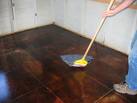WHICH CONCRETE SEALER APPLICATOR SHOULD I USE?
Choosing the right concrete sealer applicator is very important when trying to achieve the best coverage rate and sealer thickness for your concrete project.
Using the right tools and how a sealer is applied can affect the final outcome and performance of the sealer.
Always read the manufactures installation instructions first to see what they recommend before deciding on how you will apply the sealer. To get your concrete sealer down on the surface and give it the best chance to dry without failing, there are a few things you should think about.
- Always remember that less is better than more. You should apply sealer in multiple thin coats.
- Is the sealer solvent based or water based, this will determine how fast the liquid component evaporates?
- What is the solids content, this is usually a percent like 25%?
- What type of resin does it have, acrylic, polyurethane, or epoxy?
After finding the answers to these questions you should be able to choose the best applicator type for your project.
HERE ARE SOME DIFFERENT TYPES OF APPLICATORS:
|
AIRLESS SPRAYERS OR LPHV: (low-pressure, high-volume) These sprayers usually work best when applying most sealers. They allow very controlled coverage rates, sealing large areas in the shortest amount of time. They can handle both water based and solvent based sealers, high and low solids contents, and all types of resin. They are the most expensive. |
 |
|
PUMP UP SPRAYERS: (low pressure) These work best for spraying one part solvent based sealers with low solids content, under 35%. Make sure it can handle solvents and clean it thoroughly with a cleaning solvent so the tip and lines will not clog up for the next use. |
 |
|
PAINT TYPE ROLLER: A 3/8 to 1/4 inch nap can be used to apply both solvent and water based sealers. With a high solids content (above 35%) rolling can become a problem with solvent based sealers. High temperatures and a rough surface can create problems when rolling solvent based sealers, you might get puddling or blisters. You might want to consider spraying and back rolling when sealing textured or stamped concrete. |
 |
|
LAMB'S WOOL APPLICATOR: This is just a wooden block with the wool wrapped around it. It's best for high solids (over 35%) solvent based sealers. Works great for epoxies and polyurethanes, but is limited to smooth surfaces. |
 |
|
T-BAR: This is a metal straight edge used to pull high solids content (over 35%) polyurethane and epoxy sealers across smooth surfaces. |
 |
|
MICRO-FIBER APPLICATOR: A synthetic fiber pad best used for applying water based low solids sealers on smooth surfaces. Push and pull the sealer around maintaining a wet edge and achieving a very thin coverage rate. |
 |
|
SYNTHETIC CLOSED LOOP MOP: Use this for waxes only, move the finish around with the mop maintaining a wet edge. |
 |
Read about information on other related concrete sealer topics:
CONCRETE SEALER AND CONDENSATION PROBLEMS
CONCRETE SURFACE TEMPERATURE CAN CAUSE SEALER PROBLEMS
DEICING SALTS AND CONCRETE SEALER PROBLEMS
WHAT CAUSES SEALER BLISTERS AND BUBBLES?
SEALER SURFACE PREPARATION BEFORE SEALING
IS THERE A TINTED SEALER I CAN USE?
Return from Sealer Applicator to Concrete Sealer
Return from Sealer Applicator to Everything About Concrete Home Page














